1994 CHEVROLET CAVALIER weight
[x] Cancel search: weightPage 60 of 243
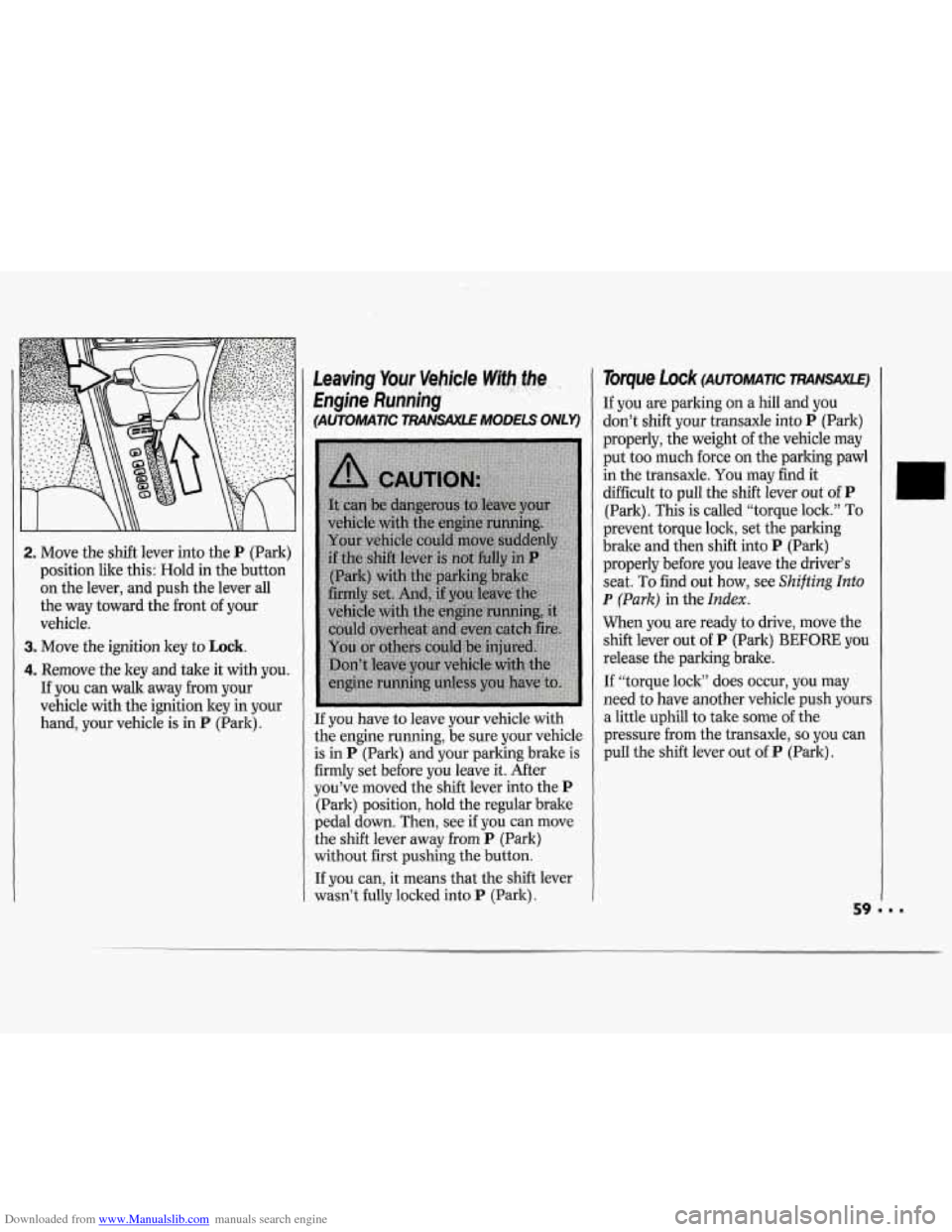
Downloaded from www.Manualslib.com manuals search engine 2. Move the shift lever into the P (Park)
position like this: Hold in the button
on the lever, and push the lever all
the way toward the front of your
vehicle.
3. Move the ignition key to Lock.
4. Remove the key and take it with you.
If you can walk away from your
vehicle with the ignition key
in your
hand, your vehicle is in
P (Park).
Leaving Yqur. Vebjcle W@h:,.the .-‘j! ., . , , :. . .
Engine Runriing ’ ’ ,. .
(AUTOllrlATIC TRANSAXLE MODELS ONLY)
If you have to leave your vehicle with
the engine running, be sure your vehicle
is in
P (Park) and your parking brake is
firmly set before you leave it. After
you’ve moved the shift lever into the
P
(Park) position, hold the regular brake
pedal down. Then, see if you can move
the shift lever away from
P (Park)
without first pushing the button.
If you can, it means that the shift lever
wasn’t fully locked into
P (Park).
Torque Lock (AUTOMATIC RWVSAXLE)
If you are parking on a hill and you
don’t shift your transaxle into
P (Park)
properly, the weight of the vehicle may
put too much force on the parking pawl
in the transaxle. You may find it
difficult to pull the shift lever out
of P
(Park). This is called “torque lock.” To
prevent torque lock, set the parking
brake and then shift into
P (Park)
properly before you leave the driver’s
seat.
To find out how, see Shifting Into
P (Park) in the Index.
When you are ready to drive, move the
shift lever out
of P (Park) BEFORE you
release the parking brake.
If “torque lock” does occur, you may
need to have another vehicle push yours
a little uphill to take some of the
pressure from the transaxle,
so you can
pull the shift lever out of
P (Park).
Page 109 of 243
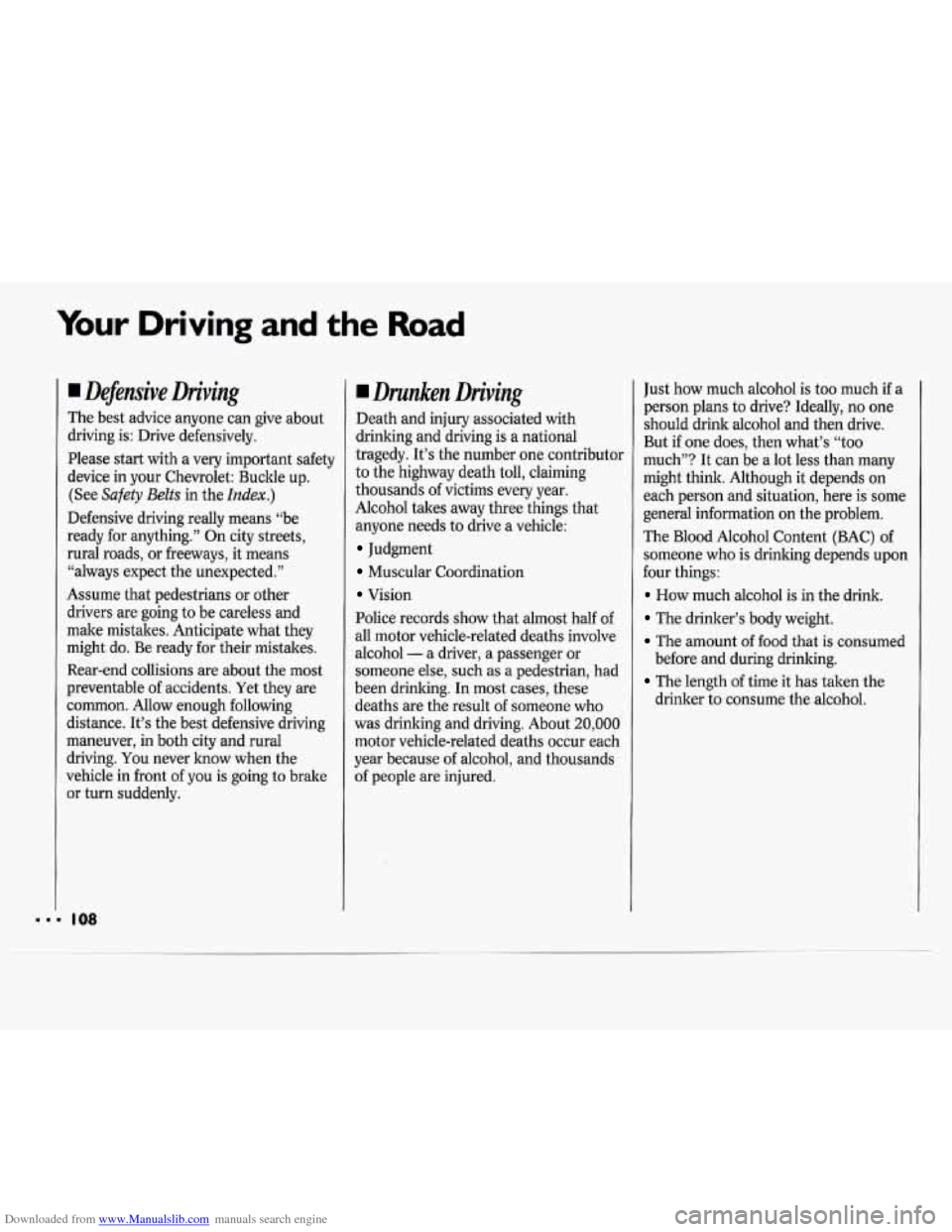
Downloaded from www.Manualslib.com manuals search engine Your Driving and the Road
Defensive Driving
The best advice anyone can give about
driving is: Drive defensively.
Please start with a very important safety
device in your Chevrolet: Buclde up.
(See
Safety Belts in the Index.)
Defensive driving really means “be
ready for anything.”
On city streets,
rural roads,
or freeways, it means
“always expect the unexpected.”
Assume that pedestrians or other
drivers are going to be careless and
make mistakes. Anticipate what they
might do.
Be ready for their mistaltes.
Rear-end collisions are about the most
preventable of accidents. Yet they are
common. Allow enough following
distance. It’s the best defensive driving
maneuver, in both city and rural
driving. You never know when the
vehicle in front of you is going
to brake
or turn suddenly.
I Drunken Driving
Death and injury associated with
drinking and driving is a national
tragedy. It’s the number one contributor
to the highway death toll, claiming
thousands of victims every year.
Alcohol takes away three things that
anyone needs to drive a vehicle:
Judgment
Muscular Coordination
Vision
Police records show that almost half of
all motor vehicle-related deaths involve
alcohol
- a driver, a passenger or
someone else, such as a pedestrian, had
been drinking. In most cases, these
deaths are the result of someone who
was drinking and driving. About
20,000
motor vehicle-related deaths occur each
year because
of alcohol, and thousands
of people are injured. Just
how much alcohol is too much if a
person plans to drive? Ideally, no one
should drink alcohol and then drive.
But
if one does, then what’s “too
much”?
It can be a lot less than many
might think. Although it depends on
each person and situation, here is some
general information on the problem.
The Blood Alcohol Content (BAC)
of
someone who is drinking depends upon
four things:
How much alcohol is in the drink.
The drinker’s body weight.
The amount of food that is consumed
before and during drinking.
The length of time it has taken the
drinker to consume the alcohol.
Page 110 of 243
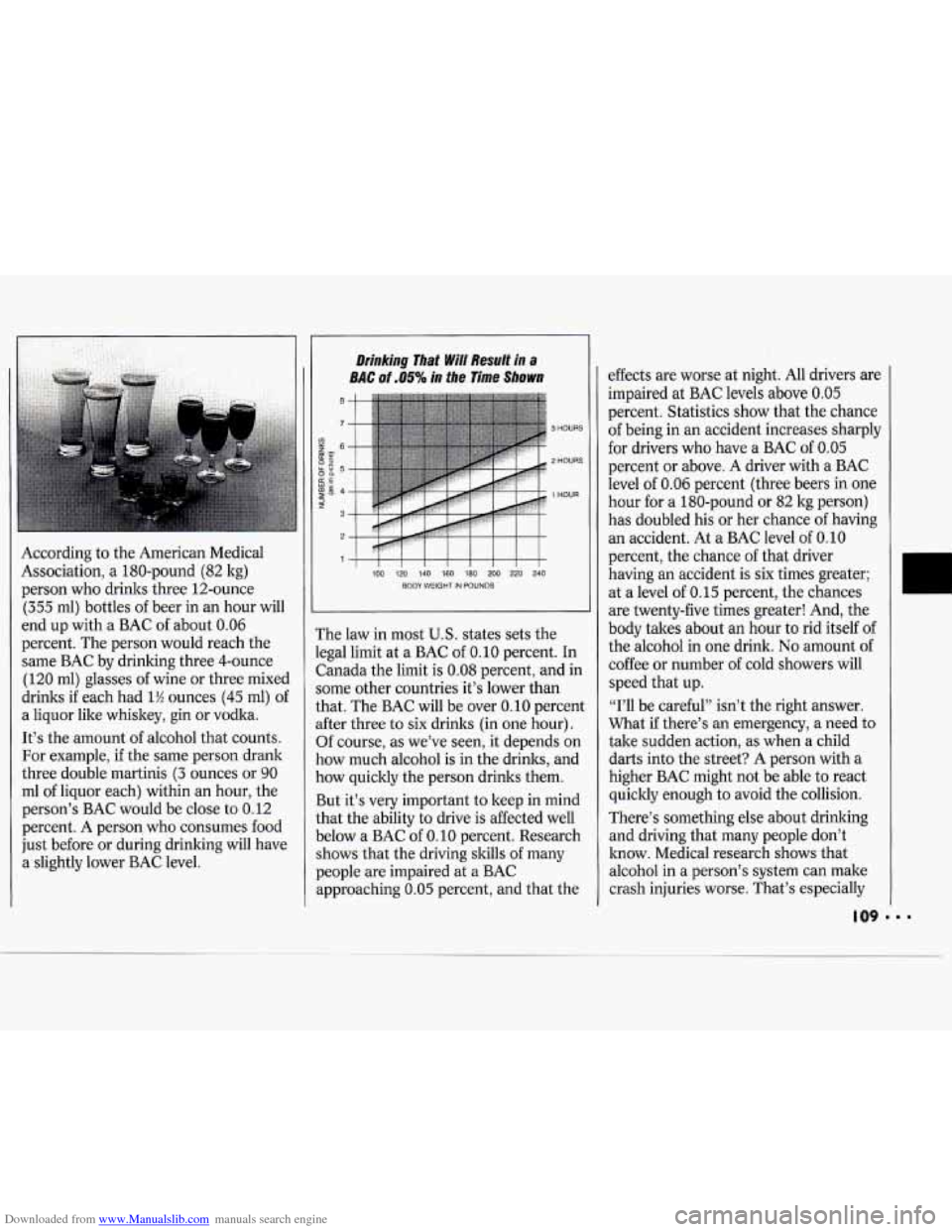
Downloaded from www.Manualslib.com manuals search engine According to the American Medical
Association, a 180-pound (82 kg)
person who drinks three 12-ounce
(355 ml) bottles of beer in an hour will
end up with a BAC
of about 0.06
percent. The person would reach the
same BAC by drinking three 4-ounce
(120 ml) glasses of wine or three mixed
drinks
if each had 1 H ounces (45 ml) of
a liquor like whiskey, gin or vodka.
It’s the amount
of alcohol that counts.
For example, if the same person drank
three double martinis
(3 ounces or 90
ml of liquor each) within an hour, the
person’s BAC would
be close to 0.12
percent. A person who consumes food
just before or during drinking will have
a slightly lower BAC level.
Drinking That WIN Resuit in a
BAC of -05% in the Time Shown
3 HOURS
2 HOURS
1 HOUR
100 120 140 160 180 200 220 240 BOQY WEIGHT IN POUNDS
rhe law in most U.S. states sets the
legal limit at a BAC of
0.10 percent. In
Canada the limit is
0.08 percent, and in
some other countries it’s lower than
that. The BAC will be over
0.10 percent
after three to six drinks (in one hour).
Of course, as we’ve seen,
it depends on
how much alcohol is in the drinks, and
how quickly the person drinks them.
But it’s very important to keep in mind
that the ability to drive is affected well
below
a BAC of 0.10 percent. Research
shows that the driving skills of many
people are impaired at a BAC
approaching
0.05 percent, and that the effects
are worse at night. All drivers are
impaired
at BAC levels above 0.05
percent. Statistics show that the chance
of being in an accident increases sharply
for drivers who have a BAC
of 0.05
percent or above. A driver with a BAC
level
of 0.06 percent (three beers in one
hour for a 180-pound or 82 kg person)
has doubled his or her chance
of having
an accident. At a BAC level of 0.10
percent, the chance of that driver
having an accident is six times greater;
at a level of 0.15 percent, the chances
are twenty-five times greater! And, the
body takes about an hour to rid itself
of
the alcohol in one drink. No amount of
coffee or number
of cold showers will
speed that up.
“I’ll be careful” isn’t the right answer.
What
if there’s an emergency, a need to
take sudden action, as when a child
darts into the street? A person with
a
higher BAC might not be able to react
quickly enough to avoid the collision.
There’s something else about drinking
and driving that many people don’t
know. Medical research shows that
alcohol in a person’s system can make
crash injuries worse. That’s especially
Page 181 of 243
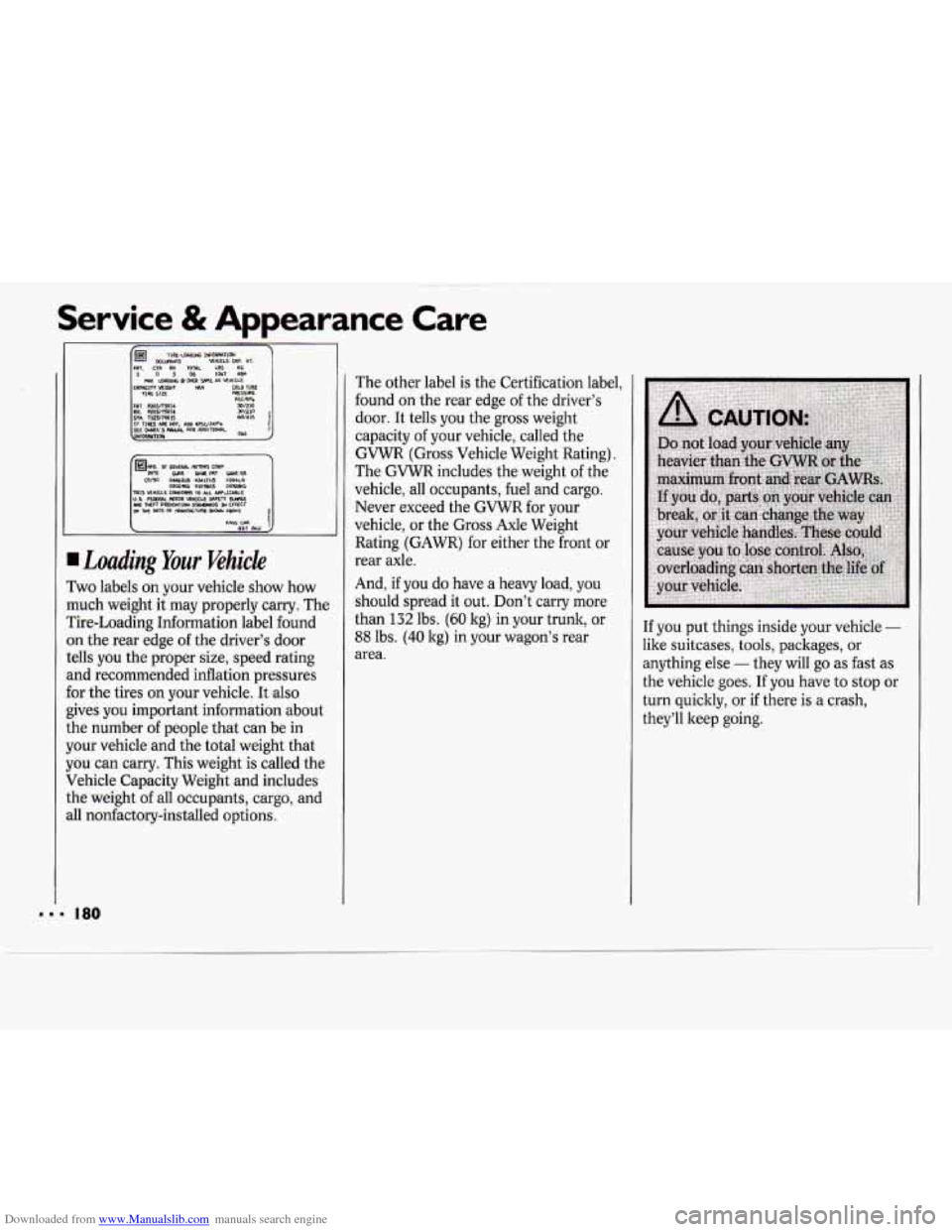
Downloaded from www.Manualslib.com manuals search engine Service & Appearance Care
I Loading Your Vehicle
Two labels on your vehicle show how
nuch weight it may properly carry. The
rire-Loading Information label found
In the rear edge of the driver's door
.ells you the proper size, speed rating
md recommended inflation pressures
or the tires on your vehicle. It also
:ives you important information about
.he number of people that can be in
four vehicle and the total weight that
rou can carry. This weight
is called the
Jehicle Capacity Weight and includes
.he weight
of all occupants, cargo, and
111 nonfactory-installed options. The other label is
the Certification label,
found on the rear edge of the driver's
door. It tells you the gross weight
capacity of your vehicle, called the
GVWR (Gross Vehicle Weight Rating).
The
GVWR includes the weight of the
vehicle, all occupants, fuel and cargo.
Never exceed the GVWR for your
vehicle,
or the Gross Axle Weight
Rating (GAWR) for either the front or
rear axle.
And, if you do have a heavy load, you
should spread it out. Don't carry more
than
132 lbs. (60 kg) in your trunk, or
88 lbs. (40 kg) in your wagon's rear
area. If you put things inside your vehicle -
like suitcases, tools, packages, or
anything else
- they will go as fast as
the vehicle goes. If you have to stop or
turn quicltly, or
if there is a crash,
they'll keep going.
Page 240 of 243
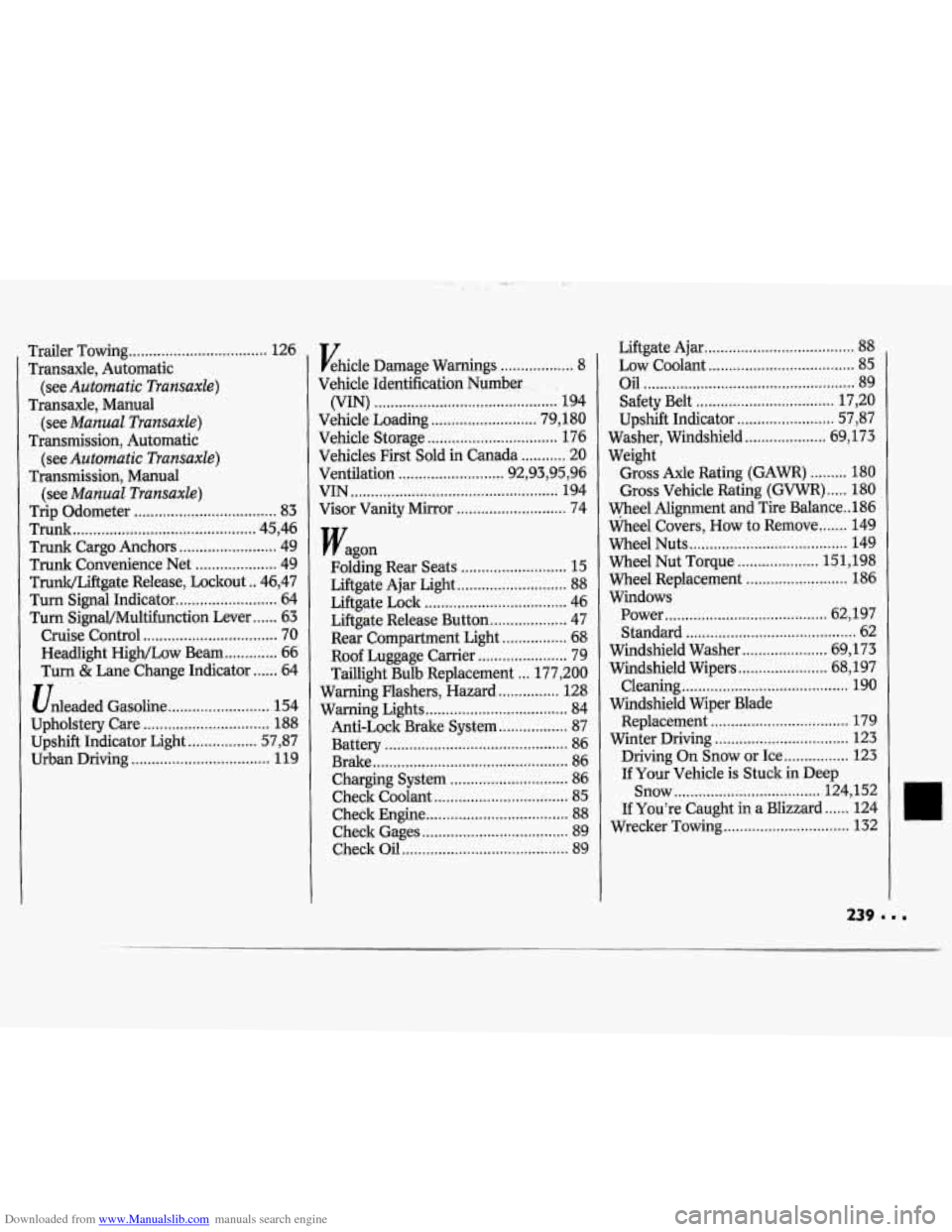
Downloaded from www.Manualslib.com manuals search engine .- . -a nr T7 . Trailer Towing .................................. ILO
hnsaxle. Automatic
(see
Automatic Transaxle)
rransaxle. Manual (see
Manual Transaxle)
rransmission. Automatic
(see
Automatic Transaxle)
Transmission. Manual
(see
Manual Transaxle)
Trip Odometer ................................... 83
Trunk ............................................. 45. 46
Trunk Cargo Anchors
........................ 49
Turn Signal Indicator
......................... 64
Turn SignaVMultifunction Lever ...... 63
Headlight High/Low Beam ............. 66
Turn
& Lane Change Indicator ...... 64
Trunk
Convenience Net
.................... 49
Trunk/Liftgate Release. Lockout
.. 46. 47
Cruise Control
................................. 70
Unleaded Gasoline
......................... 154
Upholstery Care
............................... 188
Urban Driving .................................. 119
Upshift
Indicator Light
................. 57. 87
Vehicle Damage Warnings .................. 8
Vehicle Identification Number
194
Vehicle Loading
.......................... 79. 180
Vehicle Storage 176
Vehicles First Sold in Canada
........... 20
(VIN) .............................................
................................
Ventilation .......................... 92.93.95. 96
VIN
................................................... 194
Visor Vanity Mirror
........................... 74
Wagon Folding Rear Seats
.......................... 15
Liftgate Ajar Light 88
Liftgate Lock ................................... 46
Liftgate Release Button
................... 47
Roof Luggage Carrier
...................... 79
Taillight Bulb Replacement
... 177. 200
Warning Flashers. Hazard
............... 128
Warning Lights
................................... 84
Anti-Lock Brake System
................. 87
Battery
............................................. 86
Charging System
............................. 86
.
...........................
Rear Compartment Light ................ 68
Brake
................................................ 86
Check Coolant
................................. 85
Check Engine
................................... 88
Check Oil
......................................... 89
Check Gages .................................... 89 Liftgate Ajar
..................................... 88
Oil
89
Safety Belt
.................................. 17. 20
Low Coolant
.................................... 85
Upshift
Indicator ........................ 57. 87
Washer. Windshield .................... 69. 173
Gross Vehicle Rating (GVWR)
..... 180
....................................................
Weight
Gross Axle Rating (GAWR)
......... 180
qeel Alignment and Tire Balance
.. 186
Wheel Covers. How to Remove
....... 149
Wheel Nuts
....................................... 149
Wheel Nut Torque
.................... 151. 198
Windows Wheel
Replacement
......................... 186
Power
........................................ 62. 197
Windshield Washer
..................... 69. 173
Windshield Wipers
...................... 68. 197
Standard
.......................................... 62
Cleaning
......................................... 190
Windshield Wiper Blade Replacement
.................................. 179
Winter Driving ................................. 123
Driving On Snow or Ice
................ 123
Snow
.................................... 124. 152
If You’re Caught in a Blizzard
...... 124
Wrecker Towing
............................... 132
If
Your Vehicle is Stuck
in Deep